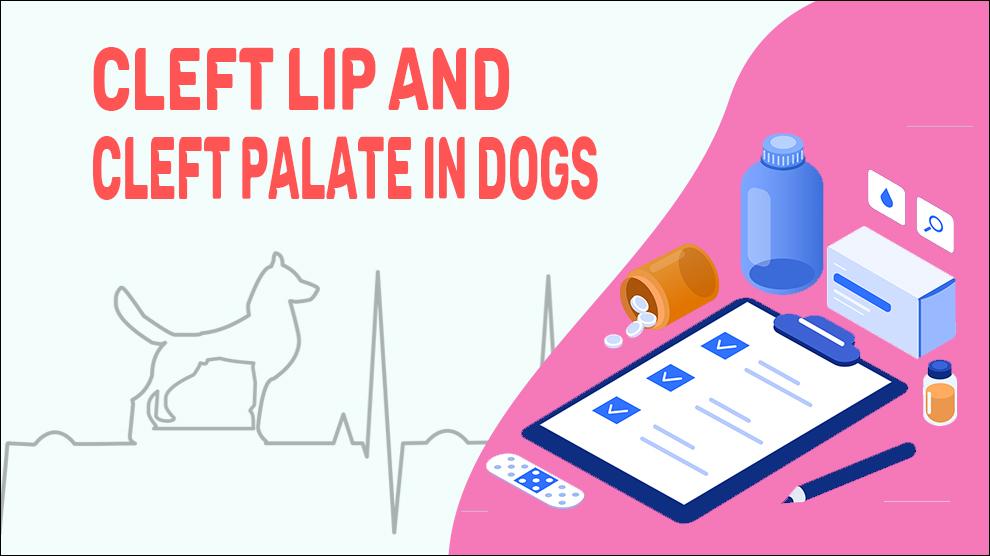A Cleft palate is a physical deformity of the mouth and/or lips that results from the inability of the mouth roof (soft and hard palates) to fuse together during standard embryological development, in that way forming a “cleft” in the roof of the mouth.
This is also called palatoschisis, congenital oronasal fistula, harelip, primary cleft, secondary cleft, and cleft lip. There are different types of cleft palates and some affect the mouth’s hard or soft palates while others affect the lips and nostrils. Collectively, these birth defects are commonly called “orofacial clefts.”
By definition, a cleft palate is a split or gap between the oral cavity (mouth) and nasal cavity (nose), which occurs when the palate tissues do not grow together completely. The cleft can extend along the flexible portion used in swallowing (soft palate), a bony portion (hard palate), or both. Simply, the result of this is a newborn dog can have a cleft palate, cleft lip, or both a cleft palate and a cleft lip.
During feeding of puppies, the cleft allows for fluid and food to enter the nasal cavity and aspirate into the lungs, potentially causing serious complications for the pet.
Symptoms Of Cleft Lip And Cleft Palate
- Primary clefts - the lip and front of the palate are obvious.
- Deformed lip / Nostril
- Breathing difficulties upon exertion.
- Coughing/snorting/milk bubbling from pups’ noses.
- Chronic infections in the sinuses.
- Stunted growth due to poor weight gain.
- Pneumonia / Infection due to food aspiration.
Treatment Options For Cleft Lip And Cleft Palate
Treatment for the soft or hard palate cleft varies depending on the age of your pet and the severity of the impairment.
Surgical correction is the only successful treatment for clefts involving the palate and lips. This repair may be comparatively simple or may be complex depending on the extent of the cleft.
Surgical closure of the clefts is advisable for puppies only after four weeks of age. Preferably, the puppy should be fed with a tube until 3 - 4 months of age to allow the oral cavity to grow larger and the opening to grow smaller.
Home Remedies For Cleft Lip And Cleft Palate
There are no home remedies for cleft palate, however, always provide the required oral care your dog needs to prevent other dental diseases.
Don’t skip routine dental checkups and Consult with your vet for guidance on teeth brushing tips.
Prevention Of Cleft Lip And Cleft Palate
Hereditary is the factor in some breeds for cleft palate and it is better to evaluate the affected dogs before breeding or at least before getting a dog from a susceptible lineage.
Affected Breeds Of Cleft Lip And Cleft Palate
Boston Terrier, French Bulldog, Papillon, English Bulldog, Italian Greyhound, Labrador Retriever, Cavalier King Charles Spaniel, Australian Shepherd
Additional Facts For Cleft Lip And Cleft Palate
- Causes:
Cleft lip and cleft palates are congenital. Purebred dogs and brachycephalic breeds are more likely to have cleft lips than mixed breeds.
Nova Scotia duck tolling retrievers (CP1 mutation) and Bulldog breeds are especially at risk.
- Types:
- Primary palate - This is found on the lip and /or harelip.
- Secondary palate - This is found posterior to incisive foramen in the soft and hard palate.
- Mortality:
There is no mortality in adult dogs associated with cleft lip and cleft palate documented yet. However, when a newborn pup is unable to suckle the mother’s milk, it becomes malnourished and there is a chance of death for the puppy.
- Diagnosis:
- Normal physical exam
- Routine dental exam
- Dental X-rays
- Prognosis:
Cleft palate surgery for adult dogs is not necessary, but the surgery is done when the cleft palate is cosmetically unacceptable. Usually, the surgery has a low success rate. Always contact a board-certified surgeon or board-certified veterinary dentist for the surgery.
When To See A Vet
Time to visit the vet clinic for an examination, if you notice any of the following:
- Primary clefts - the lip and front of the palate are obvious.
- Deformed lip / Nostril
Food Suggestions For Cleft Lip And Cleft Palate
Best foods:
- Fiber-rich fruits and vegetables.
- Foods with fluoride including dehydrated soups.
- Cheese, milk, plain yogurt, and other dairy products.
- Bones (raw, not cooked), cooked chicken giblets (hearts, liver, gizzards).
- Dental diet-approved kibble and treats.
Foods to avoid:
- Starchy foods can get stuck in the mouth.
- Chewy, sticky, and hard candy.
- Crackers, Popcorn
- Rice and potato-based dental sticks.
Conclusion
The sad news is many cleft lip/palate pets are euthanized right away after their deformity is detected. However, many of these puppies will survive if handled with sufficient care and diligence. Prevention also involves breeding more carefully for traits that will reduce the risk of cleft lip/ palate defects. Generally breeding for brachycephalic traits such as exaggerated short, wide skull, undershot jaw, and snub nose will increase the risk of cleft palates.

















